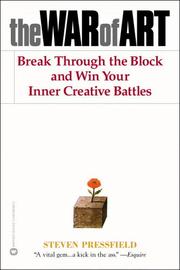The War of Art
Break Through the Blocks and Win Your Inner Creative Battles
Break Through the Blocks and Win Your Inner Creative Battles
I was excited when I found this book because of how often I heard it recommended for creative types or really for anybody who creates. At only one hundred and sixty-five pages it should have been a quick read, but sadly I never made it that far. Spoilers ahead…
The war described in The War of Art is the inner conflict one experiences while sharing one’s art with the world. This concept is truly inspired and likely the source of the book’s popularity.
Bringing one’s art to the world take work. Steven describes a difference in the way an amateur and a professional approach work. An amateur does something for the love or the reward of doing it, whereas a professional does something even if he or she does not love it. People avoid suffering. It seems to me if work was all fun and games there would be little need for a separate word. Steven takes this drive to avoid the unpleasant aspects of work and brings it to life as a force of nature. Think of this like the Norse god Loki, if Loki was focused on preventing you from being productive. He calls the force Resistance. These are some fascinating ideas that could be explored effectively in a short persuasive essay. Unfortunately this was not a short persuasive essay.
To me his concept is not about professional vs. amateur, it is about an understanding what it means to work toward a goal. Work is the journey toward the goal. Often it is not just doing something, it is doing something that requires persistence, sacrifice, courage, and commitment. Part of what makes the goal valuable is overcoming the adversity required to achieve it.
The rest of my progress through the book was akin to the Kübler-Ross five stages of grief. I discovered no more clever insights and began to wonder if this was some kind of social experiment. The fact that the material could be stretched to 165 pages should result in some kind of instant notoriety, perhaps a golden rubber-band award. It was like reading an example writing assignment designed to demonstrate what tricks a student might use to stretch their page count. I imagined the publisher demanding 165 pages so the work could be sold as a book, and Steven hell bent on delivering. His battle with Resistance could not be won with words alone, he simply did not have enough, so extraordinary measures were needed. Things like pages with a single sentence, or the type kerning so wide that one expects it was transcribed from Morse Code.
I continued to read with the hope that I could find a way he could express his ideas in a more traditional book form. The best I could come up with was to propose he write a new book, divided into three sections.
- A short persuasive essay introducing his idea of Resistance.
- A set of techniques one could employ to keep slogging away at one’s craft in the face of adversity. Resistance be damned!
- A collection of success stories from people who achieved greatness using Steven’s techniques. There would be nothing better than to thrill in their victory, blowing raspberries in the face of Resistance.
I dearly hope Steven will consider such an endeavor. Despite my criticism, I enjoyed Steven’s writing. I think will check out some of his fiction.
Ultimately I quit the book, as continuing to read it would only have let Resistance win.

